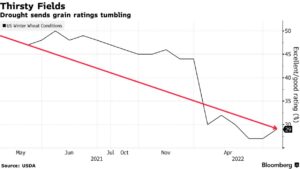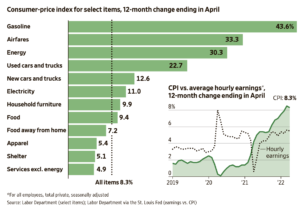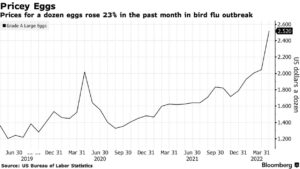The USDA is projecting that the ag trade deficit will shrink in FY2026 even more than previously anticipated. USDA expects the trade deficit to fall from $43.7 billion in FY2025…
Global Wheat Production Faces Weather Threats, While U.S. Food Prices Climb
Bloomberg writers Megan Durisin, Kim Chipman, Jen Skerritt, and James Poole reported today that, “As Russia’s invasion chokes off Ukrainian wheat exports, pushing up bread and noodle prices, the global harvest faces an added test: extreme weather.
“Droughts, flooding and heatwaves threaten output from the U.S. to France and India, compounding shrinking production in Ukraine. Just about every major producing region is facing one threat or another. The one notable exception is Russia, which is shaping up for a bumper crop and stands to benefit from the rising prices and limited supply elsewhere.

“Warm, dry weather is a burgeoning concern” in the EU, while “dryness [is] plaguing the U.S. Central Plains,” and “[Canadian] producers are now trying to plant in fields that are either too wet or too dry,” the Bloomberg article said.

India is facing “blistering heat,” while “there are concerns about [China’s] winter wheat after unusual autumn floods.”
The Bloomberg article added that, “Russia has also seen favorable weather and could reap a near-record harvest.”
Meanwhile, Keith Bradsher reported in today’s New York Times that, “China’s winter wheat harvest next month is one of the big uncertainties in a global economy already struggling with high commodity prices, particularly in regions heavily dependent on crops from Russia and Ukraine.
If the Chinese harvest is bad in the coming weeks, it could drive food prices up further, compounding hunger and poverty in the world’s poorest countries.
And Reuters writers Naveen Thukral and Hallie Gu reported today that, “Argentina’s wheat harvest for the 2022/23 season is expected to be around 19 million tonnes, down from the 22.1 million tonnes harvested in the previous season, the Rosario Grains Exchange (BCR) said on Wednesday.”
More narrowly on U.S. production variables, Patrick Thomas and Kirk Maltais reported in today’s Wall Street Journal that, “Farmers are in a race against the clock to get their crops in the ground this week, with planting of corn, soybeans and wheat well behind their usual pace.”
Cornbelt #Plant22 windows tighten. Hot/dry conditions across the central/eastern Cornbelt look short-lived. Another run of active weather, heavy rainfall producing t-storms possible next week. N. Plains remain wet.
— Andrew Pritchard (@skydrama) May 11, 2022
Probability of more than 1" precipitation next 10 days from EPS: pic.twitter.com/auKizoZ4vY
And with respect to edible oils, Laura Reiley reported in today’s Washington Post that, “Extreme weather and the war in Ukraine have tightened global supplies of the four most commonly used types of vegetable oil — staple ingredients that are as ubiquitous in home kitchens as they are in restaurants and packaged foods. In low-income countries, cooking oil represents one of the biggest weekly expenditures for poor families and the sour.”
As production variables evolve across key global growing regions, U.S. food prices continue to climb.
Rachel Siegel reported on the front page of today’s Washington Post that, “Inflation eased slightly in April, showing some of the slowest gains since last summer, although it remains at a 40-year high and has a long way to fall before Americans feel relief.

“Data released Wednesday by the Bureau of Labor Statistics gave policymakers nascent hope that soaring inflation may be starting to slow: prices rose 8.3 percent in April compared with a year ago, and 0.3 percent compared with the month before. By contrast, March prices rose 8.5 percent compared with the previous year, and a sharper 1.2 percent compared with the previous month.”
Here’s where Americans are seeing big jumps in prices:
— Heather Long (@byHeatherLong) May 11, 2022
Gas +44% y/y
Airfare 33%
Eggs 23%
Utility gas 23%
Used cars 23%
Hotels 23%
Bacon 18%
Chicken 15%
Milk 15%
Furniture 15%
Coffee 14%
Beef 14%
Flour 14%
New cars 14%
Fish 13%
Electricity 11%
Health insurance 10%
Rent 5%
“The food index increased 0.9 percent in April compared with March, notching its 17th consecutive monthly increase,” the Post article said.
Bloomberg writer Zijia Song reported yesterday that, “Egg prices are skyrocketing in new US inflation data, pushed up by a deadly bird flu that’s killed almost 10% of the country’s hens, adding to already rising food costs.

“A dozen eggs at grocery stores cost 23% more in April than in March, at $2.52. That’s the biggest increase among consumer products tracked by the US Bureau of Labor Statistics, in a report released Wednesday.”
Also yesterday, Reuters writers Trevor Hunnicutt and Jarrett Renshaw reported that, “U.S. President Joe Biden on Wednesday blamed Russia’s war on Ukraine for the latest spike in global food prices and visited a family farm in Illinois where he pledged to support the nation’s farmers as they seek to fill the supply shortage.”
The Reuters article explained that, “The White House announced actions on Wednesday aimed at helping U.S. farmers boost food production and lower food prices, including doubling funding for domestic fertilizer production and increasing technical help for nutrient management tools.
“The administration will also increase the number of counties eligible for double cropping insurance for planting a second crop on the same land in the same year, the White House said.”





